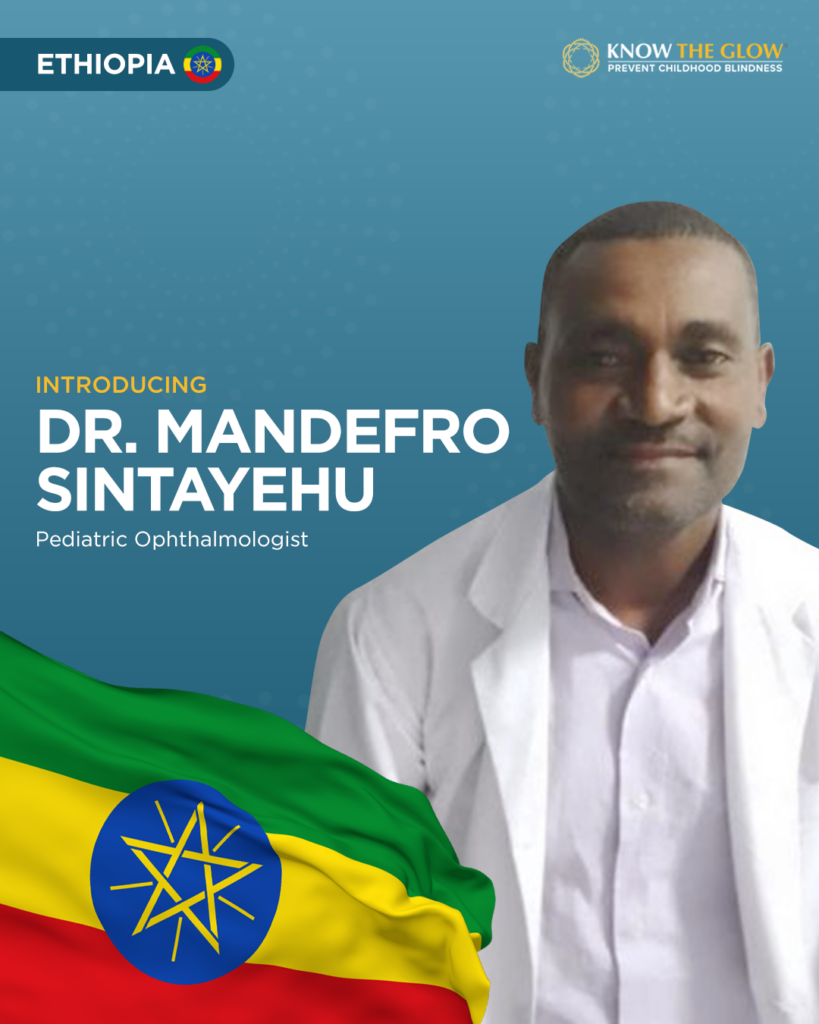One recent evening, the Know The Glow team, Megan Webber (Co-Founder) and Ruth Ngaruiya (Program Manager for Africa), met virtually with Dr. Mandefro Sintayehu, a Pediatric Ophthalmologist in Ethiopia practicing at Saint Paul Hospital Millennium Medical College. His deep emotional connection to children is what first drew him to ophthalmology and later to pediatrics.
During the conversation Dr. Mandefro mentioned that some cases, especially those involving retinoblastoma (Rb), leave a lasting impression.Too often, children arrive too late and the disease has progressed to devastating stages, sometimes presenting with large, extraocular tumors. These moments are difficult, and Dr. Mandefro could not hide his dismay knowing just how preventable some of these cases could have been. He spoke of the urgent need for earlier recognition and faster referrals, pointing out that awareness among both parents and healthcare workers is still dangerously low in many parts of the country. For him, educating both the public and frontline healthcare workers is essential. Recognizing signs like The Glow, leukocoria, could make all the difference in ensuring children are seen and treated in time.
He is a member of Ethiopia’s Retinoblastoma Task Force, a group leading national awareness and training campaigns. The Task Force was established with support from the Alliance Mondiale Contre le Cancer (AMCC). Their efforts currently underway include posters they have created in local languages, meetings with the Ministry of Health, and workshops organized for nurses and general practitioners.
Some years ago, Dr. Madefro partnered with Professor Christine Nelson on research using the EyeScreen app, which screens for signs of eye disease via smartphone. Nearly 400 children were photographed at Saint Paul and their images were analyzed by engineers abroad. The project proved successful enough to be published, and the app is still in use today though wider dissemination is needed. He sees similar potential in the Arclight ophthalmoscope, another portable, low-cost tool that could make early detection easier in remote settings for not only Rb but for the other 20 conditions the Glow can indicate as well.
Dr. Mandefro spoke with admiration for the surgical outreach and intervention model used by Cure Blindness, an organization whose mobile surgical campaigns reach even the most rural communities. Their approach is meticulous: staff go in advance to advertise screening dates at local health centers, register patients, and then the team returns on the scheduled day with transport arranged bringing families from remote villages to receive the care they need, returning them home afterward.
Still, there are challenges. Many of the children who need treatment come from families with no phones, no internet access, and no way to afford long stays in Addis Ababa while the child undergoes chemotherapy. Treatment abandonment is a major concern, which is why Dr. Mandefro holds deep appreciation for groups like TAPCCO, which offer housing and support for parents during treatment. He remembers one case in particular, a child with bilateral retinoblastoma who had to travel nearly 700 kilometers from near the Kenyan border. The child needed a full year of chemotherapy. TAPCCO made it possible for the family to stay and complete the entire course. Without that support, he says, the outcome would have been tragically different.
Clinically, he’s noticed more retinoblastoma cases coming from southern and southwestern Ethiopia, but there’s no national data yet to confirm this data. Dr. Mandefro stated that what is needed is a large-scale research study not just to track the numbers, but to better understand the “why” behind the patterns. Such a study would need international collaboration and support, but the payoff could reshape the country’s ability to respond with precision.
Dr. Mandefro’s commitment goes beyond diagnosing and treating eye conditions. He’s deeply invested in the well-being of each child and the realities their families face. This is what makes his interest in engaging with Know The Glow important. He sees KTG’s program of materials as another way to support families, raise awareness, and as he continues to look for ways to ease the burden on doctors who are stretched thin managing not just clinical care, but also education, transport, and follow-up. He’s eager to help share digital materials, slides and posters, which he believes can help caregivers notice signs they might otherwise overlook.
There is a long road ahead, but with doctors like Dr. Mandefro, there is also a clear path forward. It starts with recognizing each child as someone worth fighting for, and building the awareness and systems that ensure no child is left behind.

